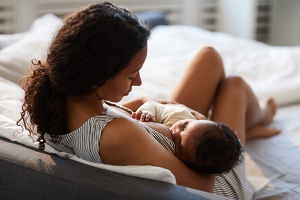
There’s one piece of sleep advice that serves parents best: Give your child the sleep support he needs, and no more. It’s that simple. Respond to his needs compassionately, and learn when to step back, because he’s got this. The “line” is tricky to find, and it shifts. Your child may need you more at certain times, less at others. But once you figure out this essential balance, you’ll become a sleep expert, supporting baby’s needs with compassion and wisdom for the rest of your parenting journey.
Here are 10 tips to help prepare children for healthy rest and increase their natural drive for sleep.
Support a child’s circadian rhythm. Forget the old “never wake a sleeping child” adage — embrace your role as your child’s guide to a regular sleep cycle. It’s perfectly appropriate to wake a child when he is sleeping at an inappropriate time (past normal wake-up time in the morning or napping too long/late in the afternoon) to protect his healthy sleep routine.
Keep a sleep log. Tracking your child’s sleep is the best way to detect patterns that will help identify root causes of any sleep troubles.
Rise and shine. Preparation for a good bedtime begins first thing in the morning. At least 15 minutes of strong light exposure combined with a morning meal tells a child’s brain that it’s time to wake up, and also helps him feel sleepy come bedtime.
Maximize melatonin. Darkness is a powerful cue regulating the body’s biorhythms and a potent sleep aid for children, as it triggers the brain’s natural production of melatonin, a hormone that regulates sleep–wake cycles. Dim the lights an hour before the time you’d like your child to be in bed.
Black out the bedroom. Nighttime light exposure interferes with the body’s production of melatonin. Every sleep doctor I’ve interviewed says the same thing: Bedrooms should be completely dark — the darker, the better. So, douse the cute nightlights — they are not necessary for babies and can be harmful to sleep quality.
Create a quiet sleeping space. Add a pure, high-quality white noise to create a constant screen of background sound that makes sudden noises less detectable, and therefore less likely to rouse your little sleeper.
Monitor room temperature. Temperature is an important physiological cue that promotes sleep. When your child or the bedroom is too warm, this natural process is interrupted. Doctors say the ideal bedroom temperature is 60–68 degrees.
Fuzzy-wuzzy is no more. It’s a myth that babies sleep best on soft, fuzzy surfaces. Fleece sheets, flannel sheets and sheepskins trap heat, which can lead to an uncomfortably warm sleep environment. Opt instead for simple cotton sheets to keep things cool.
Move that body! Physical activity promotes deep, restful sleep and is important for children of all ages, beginning at birth. For brand-new babies, this means ample time on their tummies and on their backs so they can look around, work neck muscles and wiggle their arms and legs.
Master the art of the nap. Naps support healthy development, promote restful sleep at night, and help young children rest and process new information. Naps should be long enough to be restorative — no longer. Avoid naps longer than 2½ hours; and for babies taking multiple naps, 60–90 minutes per nap may be plenty.
_________
Malia Jacobson is an award-winning health and parenting journalist and author of Ready Set Sleep: 50 Ways to Help Your Child Sleep, So You Can Sleep Too.
For more science-backed strategies and solutions for a setting a peaceful bedtime routine and resolving nighttime parenting struggles, consider getting Malia Jacobson’s ebook “Ready, Set, Sleep” at www.maliajacobson.com/readysetsleep.
Expert Local Mom Advice
Both our kids had sleep training journeys that brought me to tears. Luckily, I found a sleep coach who was both compassionate and efficient, and we were sleeping through the night about two weeks later.
Daphne Gaghagen, Chula Vista
When we went in our daughter’s room to comfort her, she would become even more aggravated when we left. We realized what worked best was to comfort her with our voices through the baby monitor. It calmed her down and she was better able to soothe herself back to sleep.
Christina Furnival, San Carlos
I love the eat-play-sleep routine for babies. From early on, allow your baby to fall asleep on his own. Then, when he wakes up in the middle of the night, he knows how to put himself back to sleep and doesn’t need milk to do it. If you’re a nursing mom, sending dad in baby’s room sends a clear message that it isn’t milk time.
Melissa Varela, Rancho Peñasquitos
When our second child stirred at night, we waited 5-10 minutes before checking in—as long as he wasn’t bawling. Many times he would fuss a little, then put himself back to sleep.
Anne Malinoski, Santee














